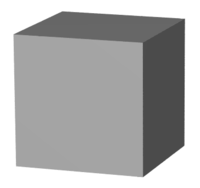|
|
| Line 1: |
Line 1: |
| | + | [[Image:Cube.png|200px|right]] |
| | ==Equations== | | ==Equations== |
| | For cubes of edge-length 2''R'' (volume <math>V_{cube}=(2R)^3</math>): | | For cubes of edge-length 2''R'' (volume <math>V_{cube}=(2R)^3</math>): |
Latest revision as of 16:07, 13 June 2014
Equations
For cubes of edge-length 2R (volume  ):
):
Form Factor Amplitude

Isotropic Form Factor Intensity

Sources
Byeongdu Lee (APS)
From Supplementary Information of: Matthew R. Jones, Robert J. Macfarlane, Byeongdu Lee, Jian Zhang, Kaylie L. Young, Andrew J. Senesi, and Chad A. Mirkin "DNA-nanoparticle superlattices formed from anisotropic building blocks" Nature Materials 9, 913-917, 2010. doi: 10.1038/nmat2870

Where 2R is the edge length of the cube, such that the volume is:

and sinc is the unnormalized sinc function:

Pedersen
From Pedersen review, Analysis of small-angle scattering data from colloids and polymer solutions: modeling and least-squares fitting Jan Skov Pedersen, Advances in Colloid and Interface Science 1997, 70, 171. doi: 10.1016/S0001-8686(97)00312-6
For a rectangular parallelepipedon with edges a, b, and c:

For a cube of edge length a this would be:

Derivations
Form Factor
For a cube of edge-length 2R, the volume is:

We integrate over the interior of the cube, using Cartesian coordinates:



Such that:

Each integral is of the same form:
![{\displaystyle {\begin{alignedat}{2}f_{cube,x}(q_{x})&=\int _{-R}^{R}e^{iq_{x}x}\mathrm {d} x\\&=\int _{-R}^{R}\left[\cos(q_{x}x)+i\sin(q_{x}x)\right]\mathrm {d} x\\&=\left[{\frac {-1}{q_{x}}}\sin(q_{x}x)+{\frac {i}{q_{x}}}\cos(q_{x}x)\right]_{x=-R}^{R}\\&=\left[{\frac {-1}{q_{x}}}\sin(q_{x}R)+{\frac {i}{q_{x}}}\cos(q_{x}R)-{\frac {-1}{q_{x}}}\sin(-q_{x}R)-{\frac {i}{q_{x}}}\cos(-q_{x}R)\right]\\&=\left[-{\frac {1}{q_{x}}}\sin(q_{x}R)-{\frac {1}{q_{x}}}\sin(q_{x}R)\right]\\&=-{\frac {2}{q_{x}}}\sin(q_{x}R)\\\end{alignedat}}}](https://wikimedia.org/api/rest_v1/media/math/render/svg/8b001f45f341accdbdce141a9f6d1fa9a97d5921)
Which gives:

Form Factor at q=0
At small q:

Isotropic Form Factor
To average over all possible orientations, we note:

and use:

From symmetry, it is sufficient to integrate over only one of the eight octants:

Isotropic Form Factor Intensity
To average over all possible orientations, we note:

and use:

Solving integrals that involve nested trigonometric functions is not generally possible. However we can simplify in preparation for performing the integrals numerically:

From symmetry, it is sufficient to integrate over only one of the eight octants:

Isotropic Form Factor Intensity contribution when  =0
=0
The integrand of the  -integral becomes:
-integral becomes:

For small  , the various
, the various  can be replaced by
can be replaced by  , and the various
, and the various  can be replaced by
can be replaced by  :
:

Which is a constant (with respect to  ). The part of the
). The part of the  -integral near
-integral near  has the contribution:
has the contribution:

Isotropic Form Factor Intensity at q=0
At very small q:















![{\displaystyle {\begin{alignedat}{2}f_{cube,x}(q_{x})&=\int _{-R}^{R}e^{iq_{x}x}\mathrm {d} x\\&=\int _{-R}^{R}\left[\cos(q_{x}x)+i\sin(q_{x}x)\right]\mathrm {d} x\\&=\left[{\frac {-1}{q_{x}}}\sin(q_{x}x)+{\frac {i}{q_{x}}}\cos(q_{x}x)\right]_{x=-R}^{R}\\&=\left[{\frac {-1}{q_{x}}}\sin(q_{x}R)+{\frac {i}{q_{x}}}\cos(q_{x}R)-{\frac {-1}{q_{x}}}\sin(-q_{x}R)-{\frac {i}{q_{x}}}\cos(-q_{x}R)\right]\\&=\left[-{\frac {1}{q_{x}}}\sin(q_{x}R)-{\frac {1}{q_{x}}}\sin(q_{x}R)\right]\\&=-{\frac {2}{q_{x}}}\sin(q_{x}R)\\\end{alignedat}}}](https://wikimedia.org/api/rest_v1/media/math/render/svg/8b001f45f341accdbdce141a9f6d1fa9a97d5921)















